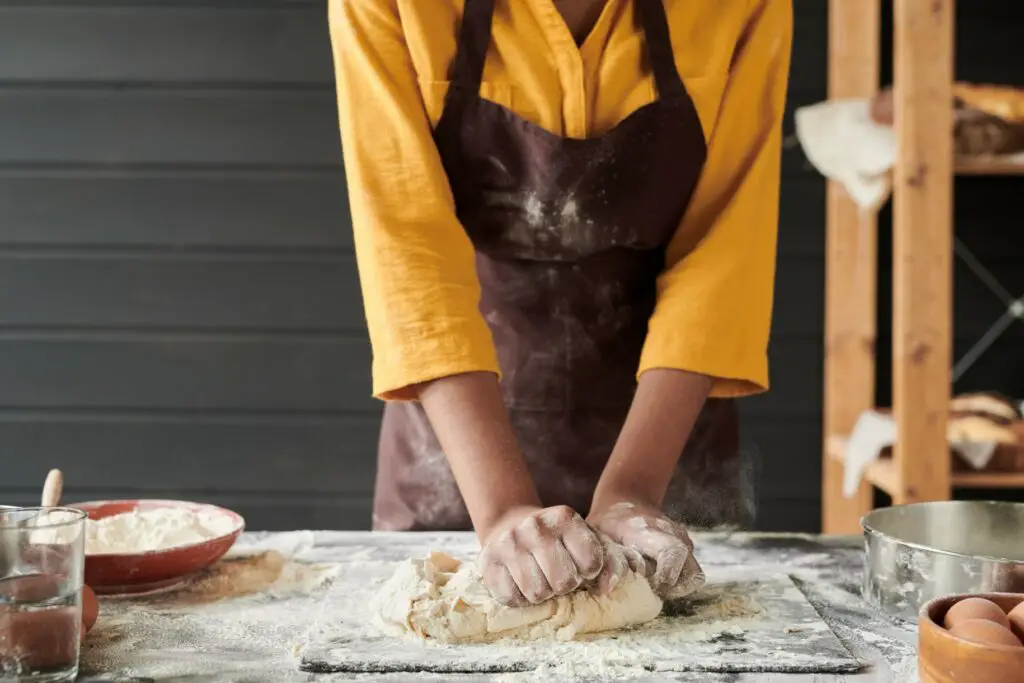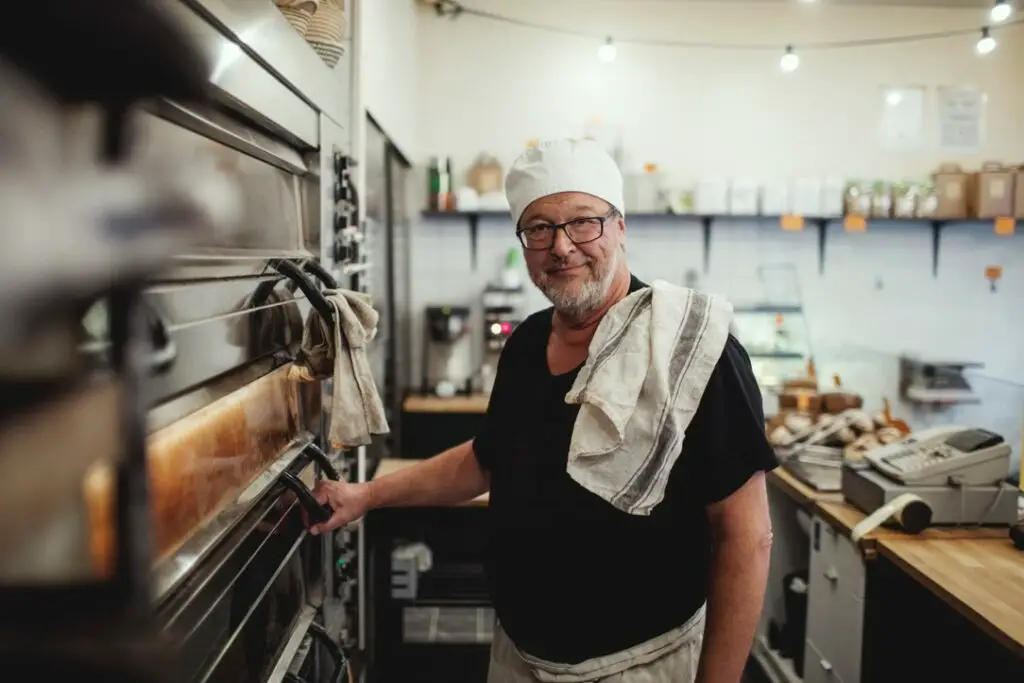Every career has its safety risks, and the same goes for a career in culinary. Yet many chefs say that despite the safety hazards related to being a chef, they would still choose it as a career as they are passionate about cooking and derive fulfilment from preparing meals that others find satisfying.
Still, if you are on the brink of a culinary career, it is worthwhile to find out how safe it is to be a chef and how to minimise the potential hazards. This way, you can decide if you are willing to contend with these before becoming a chef.
As an existing chef, the greater your awareness of the safety hazards and coupled safety measures, the safer you make being a chef.
Is it safe to be a chef?
While it is not safe to be a chef because of risks to physical well-being like cuts or burns, long-term health issues like back or feet problems, mental well-being because of long work hours, fatigue, and social isolation, there are many safety and preventative measures to make being a chef safer.
This article considers the following:
- The most significant safety risks that chefs face.
- Why injuries occur.
- Preventative measures that, when followed, can reduce the risks of harm to physical safety, health and mental well-being.
3 Greatest safety risks to being a chef.
1. Risks of physical injury like cuts, burns and falls.
A commercial kitchen is filled with hazards, and personal safety can be compromised when accidents occur. Cuts, burns and falls are common accidents whilst working in the kitchen.
Injuries to the hands and other parts of the body can occur from:
Working with knives.
While knives are a chef’s most important tool, they carry potential safety risks from accidents or when not handled correctly.
Knife injuries to the hand range from simple cuts requiring only a plaster to deep ones needing stitches or where nerve endings are damaged. Worse is when the tip or a whole finger is amputated.
Knife injuries are commonly caused by:
- Blunt knives, as this means extra pressure is needed to cut.
- Knives slipping when not using the right knife for the job, cutting towards you, rather than away or not first halving food like onions before cutting, allowing you to cut on a flat surface or using a knife to cut something other than food.

Handling kitchen tools and equipment.
Faulty kitchen appliances, incorrect use, and not following safety procedures when handling kitchen equipment can result in injuries.
Using the wrong tool to get the job done.
Using a short handle rather than a long handle tool when working with a deep fryer or using a plastic crate that is unstable rather than a step stool to reach an object on a top shelf are examples of using the wrong tool that could easily result in a kitchen injury.
Burns.
Burns can occur from:
- Touching hot pans, pots, and oven dishes with your bare hands rather than a hand towel or protective gloves.
- Splashes and spills from hot water, oil or food.
Incorrectly handling objects.
These include injuries from moving a heavy pot with hot contents from the stove, alone, rather than asking for help.
Wearing unsuitable gear.
Chef jackets, for example, with loose, flapping rather than tighter fitting sleeves, risk catching fire when close to stoves.
Hair not covered and tucked away from the face is at risk of catching fire when coming too close to a flame.
When chefs are not wearing non-slip, comfortable shoes with steel tips on the inside, they risk slipping and getting injured when objects fall on their feet or sore feet from the strain of standing long hours.
Slips, trips and falls.
These can occur when spills are not wiped immediately, floors are not cleaned regularly, leaving them greasy or when obstacles are left in walkways.
Washing dishes.
Washing dishes by hand could cause cuts when sharp knives are left in the water or glass breaks in the washing process.
Poor communication in the kitchen.
When chefs move around in the kitchen carrying sharp knives or hot pots, they warn others as they approach them from behind or in front that they are carrying potentially dangerous objects.
A lack of doing so could result in accidents and injury.
Unsafe kitchen procedures.
Unnecessary accidents can occur by not constantly problem-solving to generate the best safety procedures.
For example, rather than randomly placing knives in water to be washed and risking a hand cut, having a container for dirty blades next to the washbasin may be best. This creates greater awareness to proceed cautiously in getting the knives cleaned.
2. Health risks to body parts like the hands, feet and back.
Working in a kitchen can place your short and long-term health at risk due to the following:
Injury to legs, feet and back from prolonged standing.
Besides physical fatigue, standing for prolonged periods, especially when standing with an incorrect posture, places the chef’s health at risk to things like:
- Hip and chronic lower back pain,
- joint pressure, pain and arthritis,
- muscle fatigue in knees and legs, cramps and swelling of legs, and varicose veins,
- foot problems like bunions and corns,
- Illnesses like plantar fasciitis, pain to the heel and arch of the foot.
- Cardiovascular problems.
Injury to the wrist and hand, like carpal syndrome.
Injury to the hand and wrist mainly occurs with activities requiring repetitive hand motion, such as whisking, stirring, kneading, chopping or cutting. This can range from injuries like a wrist sprain and tendinitis to more serious ones like carpal syndrome.

Those new to the chef profession can suffer from injuries like tendonitis, which stems from a sudden, increased use of the hand, as in cutting.
It is the day-in and day-out of the faulty repetitive motion, over time, that poses the most significant health risks to injuries like carpal syndrome rather than infrequent activities requiring repetitive motion. The risk of injury is heightened when holding the wrist, arm, and shoulder at an awkward angle, bending the neck and back, and working with forceful movements.
3. Risks to mental and emotional well-being.
The working conditions of chefs can put their psychological well-being at risk due to the following:
Overly long work hours with minimal breaks.
This result is mental and physical fatigue, which can negatively impact mood, leading to feelings of irritability, emotional volatility and an overall lowering of coping resources.
Disruption in typical patterns of life.
Long hours and shifts disrupt the typical pattern of life: Sleep, nutrition, exercise and family life.
Sleep: From observing our son, a culinary student in industry training, he is not always sure on any given week, which days he’ll be working, which days he’s off, or whether he’s doing the morning or the evening shift.
Constant schedule changes can affect the circadian rhythm of the body (24-hour body cycle) and cause disruptions in sleep patterns. This could lead to sleep deprivation in quality and quantity and tiredness.
Nutrition: Our son’s colleague stopped at a fast-food outlet after an evening shift because he didn’t have the physical capacity to come home and prepare a meal to eat after the long shift of the day.
Good nutrition, in turn, is essential to fuel the body and aid both physical and mental resilience.
Exercise: Our son, in turn, is finding it hard to exercise at the same pace he used to. Having been in a swim club, work hours make it difficult to train at the pace and time as everybody else.
Exercise releases feel-good chemicals in the body like serotonin and is essential for strengthening our physical and mental resilience to cope better with our demands.
Family life: Chefs may often work at critical times of family interactions, like at the dinner table or weekends. One of the chefs where our son works mentioned how challenging it is to spend time with his son when he works on weekends.
Furthermore, chefs may only sometimes be able to provide critical support for the smooth running of family life, like helping with school trips, taking kids to extracurricular activities, or attending parent meetings. This can strain family life and relationships.
Working under pressure in hot, noisy kitchens.
There are several stressors when working in a commercial kitchen environment.
For one, evening shifts are incredibly stressful and anxiety-provoking for chefs with the pressure of doing orders that come in at a rapid rate and must be done with quality and speed, not to keep customers waiting too long.
The leadership you are working under also plays a role, says our culinary son. When the sous or executive chef is calm and composed under pressure, it makes everyone cope much better with working under pressure. When they are high-strung, it creates a tense atmosphere in the kitchen and increases the kitchen staff’s anxiety level.
Insufficient coping mechanisms.
The culinary industry is rife with drug and alcohol abuse as a way of coping with the pressures of the industry.
A friend of our son’s said he started smoking during his industry training to cope with the stress he experienced working in the restaurant industry.
Whilst many chefs experience mental health issues coping with the industry’s strain, there is still a stigma to asking for support and talking about it. The result is that they suffer in silence and cope in ways that cause more problems than it solves.
Reasons why safety measures are not adhered to.
Many safety measures are available to prevent injury, like following best practices when working with knives, hot pots and pans, oil and water and for best body posture for standing and working with your hands.
Still, kitchen injuries happen, and some, like knife cuts and burns, remain common. A significant reason is that safety best practices are not always adhered to, resulting in accidents and injuries.
To make being a chef even safer, it is necessary to address why safety measures are not religiously adhered to, as doing so can minimise risk to health and safety.
These are:
1. Lack of awareness of the health and safety risks.
When chefs are aware right from training days of the safety and health risks of being a chef, maximised by neglecting preventative measures, they are more likely to adhere to these.
When a chef is unaware that, for example, the strain on the hand and wrist from repetitive hand motion when cutting and chopping can lead to carpel tunnel, they are unlikely to take precautionary measures like breaking the movement by stretching their hand or alternating activities.
2. Lack of knowledge of best safety practices.
Chefs need a comprehensive knowledge of the various best practices to prevent injury and why they must adhere to it.
When a chef doesn’t know, for example, that an upright posture when standing with the back straight and shoulders upright is essential to avoid lower back and hand injuries, as the nerves operating the fingers start in the neck and slouching hinders motion of the hands as it places strain on the neck and shoulders, they are less likely to do this.
3. Incorrect attitudes to safety and health.
The reality is that only some chefs are committed to their health and safety and thus may be careless about it and give the industry a bad name, discouraging would-be chefs concerned about the dangers of being a chef.
4. Time pressure results in neglecting safety measures.
As chefs are under pressure, especially during service time, they may neglect to follow needed safety measures, which could result in injuries.
This time pressure could also result in a chef paying scant attention to an injury requiring more severe intervention.
5. Overconfidence in their skill.
While your confidence grows as you become a more skilled and experienced chef, you may also become more relaxed about following safety methods.
No matter how skilled and experienced one becomes, the kitchen remains full of potential hazards, and it’s essential always to be aware of this.
6. Overly task and less health and safety focused.
So many chefs are passionate about what they do and can become overly task focussed on doing an excellent job but less focused on health and well-being. Rather than attend to physical discomforts like leg or back pains, they push themselves to perform and worry about the health consequences later.
Younger chefs may not initially feel the strain of many hours of standing and repetitive hand motion:
- They may have a short-term view of their health and hence pay little attention to the potential health dangers of not correctly standing or working with their hands.
- They are likely to develop poor habits that may be hard to break and can cause long-term injury over time.
Education and insistence on applying best practices at the outset of their training from chef instructors and senior chefs in the workplace can lead to safety measures integrated into a habitual workstyle.
7. Lack of discipline to follow repetitive safety practices.
Having the discipline to adhere to the same safety procedures daily can be tedious, resulting in a chef overlooking and becoming lax in applying these.
8. Physical and mental fatigue.
Working in a hot kitchen on your feet for hours on end with few breaks can lead to physical, mental and emotional fatigue, possibly leaving a chef less alert and cautious, making unnecessary safety errors that could lead to accidents and injuries.
9. Affordability of safety products.
Various safety products like fatigue mats or wrist braces can help chefs care for themselves and prevent injury.
Chefs, however, may only sometimes be able to afford these products: other concerns like paying for food and rent may, out of necessity, take precedence over safety products.
9 Preventative measures that make being a chef safer.
As a chef, you need to do whatever you can to minimise the risks involved and commit to taking care of your personal safety, health and well-being both in the short and long term.
Below are things chefs can do to minimise risks to their physical safety and prevent health issues.
1. Have a safety-conscious attitude.
This means:
An evergreen awareness of the risks of working in a kitchen.
Avoid becoming complacent about safety, taking for granted what you do and becoming relaxed about the preventative safety measures required when working in the kitchen.
Always be alert, paying attention to what you are doing.
Be mindful, fully aware of the task at hand and be cautious of becoming overly confident in your skills so that you become careless, leading to undue accidents.
Think safety, health and well-being.
Taking the necessary safety measures requires extra time, which you may feel you don’t have in a busy kitchen where speed is essential.
As prevention is better than cure, reframe your thinking to prioritise your safety, health and well-being above speed.
Should an accident occur and you are hurt, dealing with that takes priority. You’ll have to stop working to attend to your wound or visit a hospital if it is more serious. In time, you may also have to take time out, in any case, to consult with hand specialists to deal with hand-related illnesses like carpal tunnel, for example.
When you include safety and health best practices as part of your kitchen routine, they become part of what you do for yourself. In time you’ll probably also practice health and safety speedily.
2. Apply correct techniques, safety rules and procedures.
As a commercial kitchen is dangerous, there are correct working techniques and tons of safety do’s and don’ts for just about everything in the kitchen, from the knives you use to the chemicals used to keep the kitchen clean.
These techniques and safety measures are there to protect you. Know them well and diligently apply them to protect yourself from cuts, burns, slips and falls.
Do so until they become second nature.
Examples of some safety rules in the kitchen to prevent injuries:
To prevent knife injuries:
Correctly handle, maintain and store knives. The below video has valuable tips for knife safety:
To prevent burns:
Always:
- Keep a hand towel over your shoulder, so you have it handy for touching hot objects.

- Assume the handles of pots, pans, and casseroles are hot and touch them with a hand towel or mitten.
- Alert others when you are moving close to them with a hot pot or dish or placing it down for dishwashing so that they are alert not to touch it with their bare hands.
Wear the right clothes.
Loose-fitting clothes or hair not safely tucked away are more likely to catch fire when close to flames.
To prevent injuries from kitchen equipment:
Regularly check and service kitchen equipment. Doing so can prevent unnecessary accidents.
To prevent injuries from slips, trips and falls:
- Spills must be cleaned immediately.
- Floors must be left grease free by cleaning with the right amount of chemicals and clean mops after using so oil isn’t spread throughout the kitchen.
- Use wet floor warnings to warn others of the potential dangers of slipping.
To prevent injuries from objects like pots and pans:
- Rather than lift a pot from a burner, slide it onto a trivet.
- Rather than lift a heavy object like a food-filled pot, ask for help.
- When carrying objects like crates, ensure they are not stacked so high as to impede your vision.
To prevent injuries from chemicals in the kitchen.
Cleaning chemicals must be marked, tightly closed, and safely stored away from heat sources.
3. Take steps to prevent health problems.
There are several things chefs can do to guard against the health risks of being a chef. Here are some examples:
To stop harm to feet, legs and back from prolonged standing:
There are a few things you can do to minimise and prevent injury to your feet, legs and lower back:
Maintain a correct standing posture.
Practise keeping a correct working posture by:
- Standing upright, back and neck straight.
- Keeping your legs slightly apart, about the width of your hips.
- Distribute your weight evenly on both feet, and avoid placing your weight on your heels.
- Keep your shoulders upright.
Do a regular posture check.
This ensures that you maintain the correct standing position as often as possible throughout the day.
A regular posture check helps with the tendency to slump the shoulders, arch the lower back and let your body sag on your pelvis as you become tired. This hung posture strains your joints and muscles.
If this is difficult to remember, doing something like wearing a red armband or placing an alarm on your phone until doing posture checks becomes a habit.
Likewise, remember to shift your weight from one to the other leg every 20-30 minutes, especially if you are likely to be standing in one place for an extended time.
Use a footrest.
You can keep a nearby footrest and use it to elevate and rest one foot and then the other.
Rest off your feet as often as possible.
Whenever possible, get off your feet and sit down. Even brief periods of sitting can alleviate the strain of standing.
Foot rolling a tennis ball.
Foot rolling a tennis ball by placing it under your foot and gently rolling it back and forth for a few minutes while you are working releases tension from the arch, ball of your foot and toes, lowers blood pressure, improves circulation and the mobility of your feet.
This, in turn, has a positive effect on the alignment of your knees, hips and spine, thus aiding in preventing injury in these areas.
Doing this before you go to bed can also help you to sleep better.
The massaging effect from foot rolling not only reduces pain in the feet but also has a relaxing effect, reducing anxiety and stress.
Be very careful and safely store the tennis ball once you are done foot rolling so as not to cause additional kitchen hazards.
To prevent long-term injury to hands:
To prevent long-term harm to your hands, follow best practices that minimise strain on your hands to keep them safe from injury and avoid hand and wrist-related health issues.
Some best practices include:
- To stretch hands and wrists regularly when doing repetitive hand motion work.
- Take breaks from repetitive cutting and chopping to relax your hand.
- Use kitchen equipment to do the work wherever possible. Rather than hand whisk, use a machine.
- Be cautious when lifting, carrying, moving and opening objects. For example, open jars with care to your hands and wrists: Rather than place strain on your hands and wrist to open a tight jar, tap the lid until it pops or turn it upside down to tap lightly on a countertop until it makes a popping sound. This means the suction is broken and is now easy to open.
4. Take ownership of your safety, health and well-being.
When you take responsibility for your safety and do whatever you can to protect yourself, you make being a chef safer.
Taking ownership means:
Educating yourself: Knowing and following the correct techniques and safety procedures for food preparation and cooking and the use of kitchen tools and and equipment.
Prioritising yourself: This means putting your physical safety and health above the job and doing all necessary to take care of this.
Developing a big-picture perspective of your career, a long-term view of your health and quality of life and realise that:
Being impulsive, impatient, or careless because you are in a hurry or panicking about completing orders could cause you a finger, making you less fast and effective in the future.
Not paying attention to your body posture or resting your hands can cause long-term health issues, leaving you in pain and a lower quality of life.
5. Know basic first aid to be prepared for emergencies.
Knowing basic first aid helps to understand how to respond to cuts and burns and allows you to stay calm when an injury occurs.
Take the initiative and check that the first aid box is well stocked to ensure a speedy response, be it yours or a colleague’s emergency.
6. Do things to care for your mental-emotional well-being.
Be supportive of you and care for your mental well-being. While it may be challenging for some and takes courage, it is possible to:
Build a support system and talk about your experiences.
Building strong support with people you can talk to about the stressors you encounter helps and improves your resilience.
Journal as a way of dealing with things.
When you can’t talk or your support is unavailable, journaling about your experiences and related emotions helps alleviate those emotions’ strain. I have heard many people attest to the helpfulness of journaling in dealing with issues.
Ask for help when you are struggling.
Asking for help, especially when your coping resources are stretched to the limit, be it from a trusted and helpful family member, friend, colleague, therapist, church, helpline or chef support group. Asking for help is a sign of strength and not weakness.
Pursue the things you love.
Create time to pursue things that bring you peace, relaxation, joy and fulfilment and make you feel loved and nurtured. Whether it’s reading, hiking, or watching moves, it must have meaning for you.
Find healthy ways of dealing with issues.
Develop healthy ways of responding to difficult situations that trigger stress and anxiety, like deep breathing, problem-solving, developing optimism, especially if you tend towards pessimism, and learning to be kind to yourself.
Take care of your physical well-being.
This may seem odd when we are speaking of mental well-being. However, as we are integrated beings, what happens in your physical body impacts your mental and emotional well-being.
Experiencing pain can adversely affect your mood. Taking care of your physical well-being especially considering the work environment of a chef is essential.
This can, for example, include things like:
- Regularly drink water to stay hydrated and improve your blood flow while working.
- Soaking baths using bath salts containing Epsom salts and essential oils relax your muscles and relieve strain on your body.
- Make sure you are wearing good quality safety shoes and adding things like compression socks to improve circulation while you are standing.
Spend time outside and in nature.
Spend time outside, especially since so much of your time is spent inside during work. Spending time outside in nature, be it absorbing some sun for vitamin D, cloud gazing or walking in a park, is good for mental and emotional well-being.

7. Adapt to a different lifestyle.
Working as a chef means that you may need to adapt to how you work to have a quality lifestyle still and pay attention to what’s important to you, like health and family.
Adapting could mean:
- Preparing pre-cooked meals that need reheating so you can come home to a ready meal, especially if living on your own. This way, you take better care of your nutritional needs and are less likely to resort to fast food regularly.
- Arranging things like coffee dates with friends who can be more flexible because they work from home, for example, and can meet at times that suit your free time.
8. You always have the option of changing your career.
If you feel you can no longer handle the risks of being a chef, you always have the option of changing your career to a completely different or a culinary-related one.
Many chefs work in the restaurant industry to get experience in preparation for an alternative culinary career. Others, after spending several years in it, decide it’s time to make a change for more regular work hours or because they have had their fill of commercial kitchens.
Whatever the reasons, one has choices. An article we wrote on alternative culinary careers gives you an idea of different career paths you can pursue should you feel it’s time to make a change.
9. Invest in health and safety products.
More and more products are becoming available that chefs can use to keep themselves safe, prevent injury from accidents and take care of their health, minimising the risk of long-term health problems.
Below are some examples of helpful products:
Wrist braces
Wrist braces assist in positioning the chef’s wrist at the right angle and height when cutting or chopping.
Compression socks
Wearing well-fitting compression socks suited for long-standing aids circulation, reducing the risk of inflammation and swelling of the feet, foot pain and muscle fatigue.
Foam roller
A foam roller can stretch and lengthen the muscles in your calves and thighs. Massaging with a foam roller improves circulation, allowing blood to flow to your muscles, and relaxing the muscles that have become strained from standing.
Spiky massage ball.
Instead of the tennis ball mentioned earlier, a spiky massage ball can be used to massage under your feet and has the same benefits like relaxation, reducing stress and anxiety, relieving sore muscles and pain and preventing injury.
Anti-fatigue mat
An anti-fatigue mat softens the surface you are standing on and are designed to absorb shock and wear and tear in your joints.
Lumbar support belt
Standing in the correct posture protects your back and strengthens your abdominal muscles to improve your posture and support your entire body.
A lumber support belt can help with posture, aid muscle fatigue, and protect your back.
Kitchen tools with adaptive or ergonomic grips
Kitchen tools, like knives, with ergonomic handles, help to correctly position the chef’s hands and wrists to avoid working at an awkward angle when using knives.
Ergonomic stands
Work counters that are too low lead to chefs working at awkward angles and place strain on the neck and back. Ergonomic stands help position chefs at their best height to prevent injury that an incorrect work height could cause.


